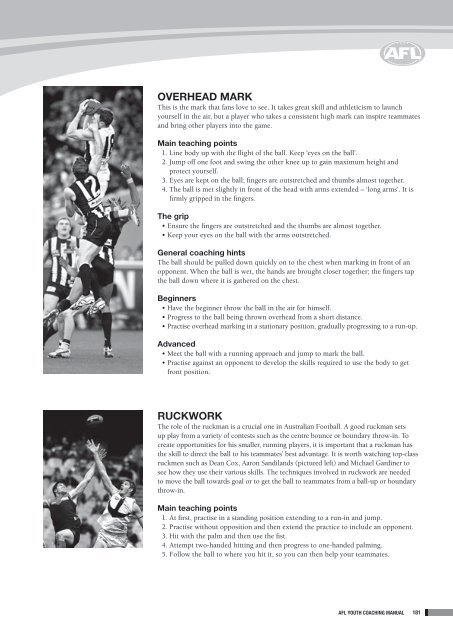2012 Youth Coaching Manual - AFL Community
2012 Youth Coaching Manual - AFL Community
2012 Youth Coaching Manual - AFL Community
You also want an ePaper? Increase the reach of your titles
YUMPU automatically turns print PDFs into web optimized ePapers that Google loves.
Overhead mark<br />
This is the mark that fans love to see. It takes great skill and athleticism to launch<br />
yourself in the air, but a player who takes a consistent high mark can inspire teammates<br />
and bring other players into the game.<br />
Main teaching points<br />
1. Line body up with the flight of the ball. Keep ‘eyes on the ball’.<br />
2. Jump off one foot and swing the other knee up to gain maximum height and<br />
protect yourself.<br />
3. Eyes are kept on the ball; fingers are outstretched and thumbs almost together.<br />
4. The ball is met slightly in front of the head with arms extended – ‘long arms’. It is<br />
firmly gripped in the fingers.<br />
The grip<br />
• Ensure the fingers are outstretched and the thumbs are almost together.<br />
• Keep your eyes on the ball with the arms outstretched.<br />
General coaching hints<br />
The ball should be pulled down quickly on to the chest when marking in front of an<br />
opponent. When the ball is wet, the hands are brought closer together; the fingers tap<br />
the ball down where it is gathered on the chest.<br />
Beginners<br />
• Have the beginner throw the ball in the air for himself.<br />
• Progress to the ball being thrown overhead from a short distance.<br />
• Practise overhead marking in a stationary position, gradually progressing to a run-up.<br />
Advanced<br />
• Meet the ball with a running approach and jump to mark the ball.<br />
• Practise against an opponent to develop the skills required to use the body to get<br />
front position.<br />
Ruckwork<br />
The role of the ruckman is a crucial one in Australian Football. A good ruckman sets<br />
up play from a variety of contests such as the centre bounce or boundary throw-in. To<br />
create opportunities for his smaller, running players, it is important that a ruckman has<br />
the skill to direct the ball to his teammates’ best advantage. It is worth watching top-class<br />
ruckmen such as Dean Cox, Aaron Sandilands (pictured left) and Michael Gardiner to<br />
see how they use their various skills. The techniques involved in ruckwork are needed<br />
to move the ball towards goal or to get the ball to teammates from a ball-up or boundary<br />
throw-in.<br />
Main teaching points<br />
1. At first, practise in a standing position extending to a run-in and jump.<br />
2. Practise without opposition and then extend the practice to include an opponent.<br />
3. Hit with the palm and then use the fist.<br />
4. Attempt two-handed hitting and then progress to one-handed palming.<br />
5. Follow the ball to where you hit it, so you can then help your teammates.<br />
<strong>AFL</strong> <strong>Youth</strong> <strong>Coaching</strong> <strong>Manual</strong><br />
181

















